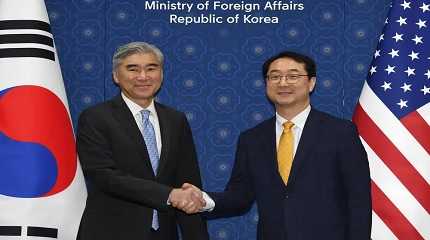
SEOUL, South Korea (AP) — North Korea on Thursday threatened unspecified “offensive action” over the expansion of U.S. military exercises with rival South Korea as President Joe Biden’s special representative for North Korea flew to Seoul for talks with allies over the North’s growing nuclear threat.
The North Korean comments came a day after the United States flew nuclear-capable B-52 bombers to the Korean Peninsula for joint aerial exercises with South Korean warplanes in their latest show of force against the North, which portrays the allies’ drills as invasion rehearsals. Animosity heightened in recent weeks as the pace of both the U.S.-South Korean military exercises and the North Korean weapons demonstrations increased in a cycle of tit-for-tat.
The North’s official Korean Central News Agency said the United States and South Korea’s military exercises and the deployment of advanced U.S. military assets have turned the Korean Peninsula into a “huge powder magazine, which can be detonated any moment.”
“The military provocations by the U.S.-led warmongers have gone beyond the tolerance limit. This reality awaits more explicit stand and answer of (North Korea’s) defense capabilities,” KCNA said in a commentary attributed to a scholar.
“(North Korea’s) war deterrence will continue to show its responsibility for and confidence in its crucial mission through offensive action,” it said.
KCNA’s commentary came as Sung Kim, the U.S. special representative to North Korea, arrived in Seoul for talks with South Korean and Japanese officials to coordinate their response to North Korea’s intensifying weapons development and threats of nuclear conflict.
Following meetings with South Korean Foreign Minister Park Jin and other South Korean officials on Thursday, Kim will take part in a three-way meeting with the South Korean and Japanese nuclear envoys on Friday, according to South Korea’s Foreign Ministry.
Kim on Thursday separately met with South Korean Foreign Minister Park Jin and chief South Korean nuclear negotiator, Kim Gunn, where they discussed strengthening joint defense postures and inducing further international efforts to crack down on illicit North Korean activities funding its weapons program, Seoul’s Foreign Ministry said.
Sung Kim and Kim Gunn during their meeting stressed the need to encourage countries to tighten their enforcement of U.N. Security Council sanctions against North Korea, including a requirement to repatriate North Korean laborers dispatched overseas, considering the possibility of North Korea reopening its borders as COVID-19 fears ease.
They also discussed seeking an active role from China – North Korea’s key ally and economic lifeline – in persuading Pyongyang to halt its weapons displays and return to denuclearization talks, according to the South Korean Foreign Ministry. Beijing and Moscow have blocked U.S.-led attempts to strengthen U.N. sanctions against the North over some of its ballistic tests, underscoring a divide in the Security Council deepened over Russia’s invasion of Ukraine.
Sung Kim and Kim Gunn are planning to participate in a three-way meeting with Japanese nuclear envoy Takehiro Funakoshi in Seoul on Friday.
North Korea in March alone fired nearly 20 missiles over seven different launch events, including an intercontinental ballistic missile that demonstrated potential range to reach the U.S. mainland and several shorter-range weapons designed to deliver nuclear strikes on South Korean targets.
The North described its tests as a response to the U.S.-South Korean drills, as the allies conducted their biggest field exercise in years last month and separately held joint aerial and naval drills involving U.S. long-range bombers and an aircraft carrier strike group.
Tensions are likely to prolong as North Korea is likely to use the allies’ continuing drills as a pretext to advance weapons development and intensify military training involving its nuclear-capable missiles.
South Korean officials say North Korea may up the ante by staging more provocative displays of its military might. Those may include the North’s first nuclear test since 2017 or test-firing an ICBM on a normal ballistic trajectory toward the Pacific, unlike its previous long-range tests that were conducted on high angles to avoid the territories of neighbors.
North Korea could possibly time some of its military displays to major holidays that fall this month, including the April 15 birthday of state founder Kim Il Sung, the grandfather of the current ruler, Kim Jong Un, and the April 25 anniversary of its army’s founding. The North also previously said it aims to finish preparations to launch a military spy satellite into space by April, an event its rivals would almost certainly see as a test of ICBM technology banned by international sanctions.
Lt. Gen. Park Ha Sik, commander of the South Korean air force operation command, said Wednesday’s drills involving B-52 bombers were aimed at displaying the allies’ “strong resolve” and “perfect readiness to respond to any provocation by North Korea swiftly and overwhelmingly.”
The United States also sent the nuclear-powered USS Nimitz aircraft carrier for joint naval training with South Korea last week and U.S.-South Korea-Japan anti-submarine drills this week.
Nuclear negotiations between the United States and North Korea have stalled since 2019 over disagreements in exchanging the release of crippling U.S.-led sanctions against the North and the North’s steps to wind down its nuclear and missile programs.
North Korea has also halted all cooperation with South Korea and tensions between the rivals have risen as the North coupled its ICBM developments with an expansion of its nuclear-capable short-range arsenal designed to overwhelm South Korean missile defenses.
Meanwhile, South Korea’s Unification Ministry, which handles inter-Korean affairs, said Thursday that Seoul would take unspecified “necessary measures” if North Korea continues to use without permission South Korean assets left behind at a now-shuttered joint factory park in the North Korean border town of Kaesong.
The ministry cited recent photos and videos published by North Korean state media that showed what appeared to be South Korean commuter buses running in the streets of Kaesong and the capital, Pyongyang.
South Korea pulled its companies out of Kaesong in 2016 following a North Korean nuclear test, removing the last remaining major symbol of cooperation between the two rivals.




